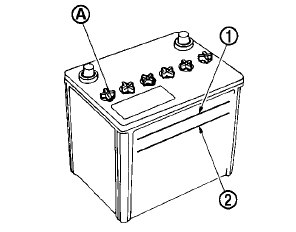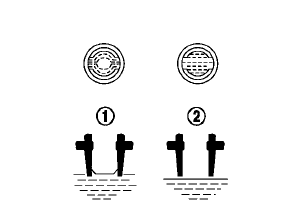Battery
• Keep the battery surface clean and dry.
Clean the battery with a solution of baking
soda and water.
• Make certain the terminal
connections are
clean and securely tightened.
• If the vehicle is not to be used
for 30 days or
longer, disconnect the negative (−) battery
terminal cable to prevent discharging it.
NOTE:
Care should be taken to avoid situations that can lead to potential battery discharge and potential no-start conditions such as:
1. Installation or extended use of electronic
accessories that consume battery
power when the engine is not running
(Phone chargers, GPS, DVD players,
etc.)
2. Vehicle is not driven regularly and/or
only driven short distances.
In these cases, the battery may need to be charged to maintain battery health.
WARNING
• Do not expose the battery to flames or electrical sparks. Hydrogen gas generated by the battery is explosive.
Do not allow battery fluid to contact your skin, eyes, fabrics, or
painted surfaces. After touching a
battery or battery cap, do not touch
or rub your eyes. Thoroughly wash
your hands. If the acid contacts your
eyes, skin or clothing, immediately
flush with water for at least 15
minutes and seek medical attention.
• Do not operate the vehicle if the
fluid in the battery is low. Low
battery fluid can cause a higher load
on the battery which can generate
heat, reduce battery life, and in
some cases lead to an explosion.
• When working on or near a battery,
always wear suitable eye protection
and remove all jewelry.
• Battery posts, terminals and related
accessories contain lead and lead
compounds. Wash hands after
handling.
• Keep the battery out of the reach of
children.

Check the fluid level in each cell. (Remove the battery cover if it is necessary.) It should be between the UPPER LEVEL 1 and LOWER LEVEL2 lines.
If it is necessary to add fluid, add only distilled water to bring the level to the indicator in each filler opening. Do not overfill.

1. Remove the cell plugs A .
2. Add distilled water up to the UPPER LEVEL
1 line.
If the side of the battery is not clear, check the distilled water level by looking directly above the cell; the condition 1 indicates OK and the conditions 2 needs more to be added.
3. Tighten cell plugs A .
Vehicles operated in high temperatures or under severe conditions require frequent checks of the battery fluid level.
JUMP STARTING
If jump starting is necessary, see “Jump starting” in the “6. In case of emergency” section. If the engine does not start by jump starting, the battery may have to be replaced. Contact a NISSAN dealer.
See also:
Exterior front
1. Front view camera (if so equipped)
2. Engine hood
3. Windshield wiper and washer switch,
wiper blades
4. Windshield-washer fluid
5. Compass display (if so equipped)
6. Power windows
7. Do ...
Care of the soft top and the vehicle body
To use your CrossCabriolet safely and comfortably,
you need to observe all the warnings and
cautions shown in the previous pages. Also, to
maintain a good appearance of the soft top and
the vehicl ...
Liftgate release
WARNING
● Always be sure the liftgate has been
closed securely to prevent it from opening
while driving.
● Do not drive with the liftgate open. This
could allow dangerous exhaust gase ...
